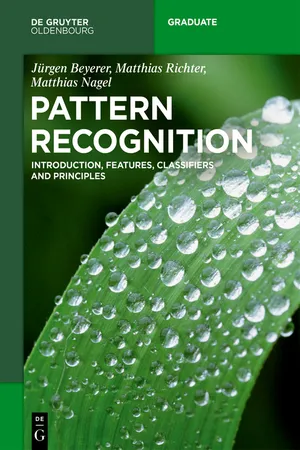
- 311 pages
- English
- ePUB (mobile friendly)
- Available on iOS & Android
Pattern Recognition
About this book
The book offers a thorough introduction to Pattern Recognition aimed at master and advanced bachelor students of engineering and the natural sciences. Besides classification - the heart of Pattern Recognition - special emphasis is put on features, their typology, their properties and their systematic construction. Additionally, general principles that govern Pattern Recognition are illustrated and explained in a comprehensible way. Rather than presenting a complete overview over the rapidly evolving field, the book is to clarifies the concepts so that the reader can easily understand the underlying ideas and the rationale behind the methods. For this purpose, the mathematical treatment of Pattern Recognition is pushed so far that the mechanisms of action become clear and visible, but not farther. Therefore, not all derivations are driven into the last mathematical detail, as a mathematician would expect it. Ideas of proofs are presented instead of complete proofs. From the authors' point of view, this concept allows to teach the essential ideas of Pattern Recognition with sufficient depth within a relatively lean book.
Mathematical methods explained thoroughly
Extremely practical approach with many examples
Based on over ten years lecture at Karlsruhe Institute of Technology
For students but also for practitioners
Frequently asked questions
- Essential is ideal for learners and professionals who enjoy exploring a wide range of subjects. Access the Essential Library with 800,000+ trusted titles and best-sellers across business, personal growth, and the humanities. Includes unlimited reading time and Standard Read Aloud voice.
- Complete: Perfect for advanced learners and researchers needing full, unrestricted access. Unlock 1.4M+ books across hundreds of subjects, including academic and specialized titles. The Complete Plan also includes advanced features like Premium Read Aloud and Research Assistant.
Please note we cannot support devices running on iOS 13 and Android 7 or earlier. Learn more about using the app.
Information
1Fundamentals and definitions
1.1Goals of pattern recognition



1.2Structure of a pattern recognition system

Table of contents
- Cover
- Title Page
- Copyright
- Preface
- Contents
- List of Tables
- List of Figures
- Notation
- Introduction
- 1 Fundamentals and definitions
- 2 Features
- 3 Bayesian decision theory
- 4 Parameter estimation
- 5 Parameter free methods
- 6 General considerations
- 7 Special classifiers
- 8 Classification with nominal features
- 9 Classifier-independent concepts
- A Solutions to the exercises
- B A primer on Lie theory
- C Random processes
- Bibliography
- Glossary
- Index